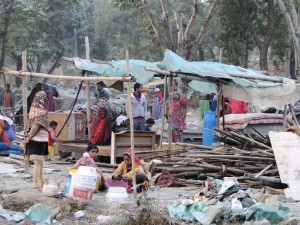In this blog post, Abhiraj Thakur, a student of NALSAR University of Law, Hyderabad writes about how PIL is misused in legal battles. The contention is based on an analysis of the PIL filed in the infamous Pitampura Slum Demolition case of New Delhi. Through close examination of the way in which the petitions were drafted by respective sides, the writer tries to highlight the blatant manipulation of law for a variety of purposes, which is unwarranted and uncalled for.
PIL and its increased usage in the current times
The legal advancement called the Public Interest Litigation (PIL) was made incidentally, to further access to equity and rights for the minimized areas of the general public, however progressively they are being utilized to facilitate the interests of private players over the general public. The article utilizes one specific site of inquiry as an example where the PILs are being put into grave abuse to hoist private enthusiasm over the general public interest.
Method of Analysis
The analysis is done by highlighting distinctions in the way the writ petitions were worded by the occupants of private property in contrast to the petitions put forward by the Jhuggi Jhopri inhabitants. Numerous legal researchers including Upendra Baxi, ex-CJI P. Sathasivam, Prasanth Bhushan among others have cautioned about the expanding abuse of PILs in the Indian legal framework to accomplish individual interest. The courts need to be careful and act delicately while conceding the PILs by examining the way of interest sought after. Further, PILs ought not to be entertained which uphold the privileges of one segment of the general population while peeling off the legitimate rights of the other segment of the general population.
The Pitampura Slum Demolition Case of New Delhi
For the need of better infrastructure facilities in the name of building a modern city, the past two decades have witnessed a striking increase in the pace of slum demotion in the capital of the country with almost a million slum dwellers being displaced since the year 1998.[1] The mushrooming of such demolitions can be attributed to the increased role of the Indian judiciary in the slum clearance drive. While earlier decision to raze the slums was shouldered by the land management agencies of the city, like Delhi Development Authority (DDA) and Municipal Corporation, Delhi (MCD); in the contemporary times, these agencies have lost their political and legal authority over such illegal inhabitations. Today, they are mostly the result of PILs filed by influential residents and trade associations which come together to label them as ‘public nuisance’ and as a result, pleading for the infringement of their ‘public rights and interest.’[2]
The present trend involves influential property owners of the locality coming together to form Resident Welfare Associations (RWA) and filing a writ petition in the court of law for the eviction of such people who illegally occupy land in their colonies. The writ petitions veiled under the disguise of ‘public interest’ are admitted by the courts, and adequate relief is granted to the residents of the property. Informal settlements are not new to the capital city. They date back to 1970’s when contractors for Asian Games sourced large immigrants from neighboring states to fulfill the construction tenders.[3] The post-millennial evictions also do not differ in the absence of rehabilitation and resettlement schemes for the displaced but differ in the increasing participation of judiciary , not- involvement of state and municipal authorities and the altered definition of ‘public interest’ which are used to sanction these PILs stripping the poor landless even of the bare necessities enjoyed by them.
PIL for demolition
On Account of slums the mushrooming at an alarming rate in the capital, KK Manchanda filed a PIL for eviction of the slums around Ashok Vihar on account of public nuisance created by them. Subsequently, a petition was filed by slum dwellers on account of the poor living conditions unlike promised by the Indian Constitution. Subsequently, the court clubbed both the categories of writ petitions under the central petition of Pitampura Sudhar Samiti[4] being centred on the same subject matter, though opposing in nature.
The manner of filing the petition is a direct reflection of the social and economic background and realization of the societal standing of the parties. The article puts forward few salient features of the respective PILs filed by Residents Welfare Association and the slum dwellers.
The Resident Welfare Association files the first set of petitions largely consisting of those filed by non-poor owners of property and land. Throughout the writ petition, the petitioners repeatedly addressed themselves as “citizens.” However, the word citizen is used to connote a local city-centric approach and not related to the national identity as it is understood. The petition repeatedly uses the words “… citizens of Delhi” and “…citizens of the city.” This can be understood as an attempt to reflect their connection to the roots of the city where they have lived for generations altogether. Also, the words “resident” has been used interchangeably with the word citizen. For instance, the petitioners use the word, “… residents of the colony” and “… an association of residents of the area.” The emphasis on the words- ‘Citizens and Residents of Delhi’ is an attempt to make the city an essential determinant for understanding citizenship. An individual’s city, as Holston holds, “is the primary political community of reference and belonging and indeed, the basis of mobilization.”[5]
PIL against demolition
This stands in sharp contrast to the terminology used by the Jhuggi Jhopri representatives in the petitions filed by them. Although we see the use of same words like ‘resident’ and ‘citizen,’ the connotation and scale are varied. They make use of words like “citizens of the country” and “citizens of India” to establish their claims of right to a dignified life. They base their claim to rights and entitlement in their economic and social vulnerability in contrast to legality. The use of words likes “daily wage laborers”, “… poor…” and “… hapless slum dwellers” appears in the writ petitions filed by them. They are considered ousters in the locality and the city through the use of words like ‘migrants’ even after having lived in the city for decades now. The judgment also entails a story of the poor rural divide to emphasise their character of being migrants or newer to the land.[6]
There are few observations to be made here
Firstly, once the land ownership is established as the basis for citizenship as such, the preservation and propriety of private property become an elevated concern for the courts. In other words, when the public is defined by ownership of land against those without property, the latter are considered second class or no citizens at all, or merely encroachers. The defence of private property and minimization of private nuisance becomes a matter of private concern.
The second observation is the blurring distinction between private and public in the discourse of nuisance in the PILs filed. The court is evidently embarking on the removal of impediments to security and welfare of private colonies which is in concurrence with the definition of private nuisance- ‘a substantial and unreasonable interference with the use or enjoyment of land, meaning private property.’[7] It is the enjoyment which forms the rationale for nuisance laws, and Mariana Valverde notes the “enjoyment of land” is not a right but a privilege that flows from the ownership of land.[8]
Conclusion
Hence, although the case falls under private interest, yet the case was filed as a Public Interest Litigation. This is against the very objective of a PIL, where the matter complained about must relate to wider public interest and not merely the interests of a private party.[9] This is similar to what Anderson pointed out in the colonial context that nuisance begins to serve as “the coercive arm of property rights, defending private interest in the name of public purpose.”[10] Thus, a boon like PIL can sometimes become a cause of concern for the wider interest of the public as has happened in this case.
Footnotes:
[1] Hari Mohan Mathur, Displacement, and Resettlement in India: The Human Cost of Development- Routledge Contemporary South Asia Series (Routledge Press, 2013).
[2] Nivedita Menon & Aditya Nigam, Power, and Contestation: India Since 1989, 78 (Zen Books, 2007).
[3] Gautam Bhan, This is no longer the city I once knew. Eviction, the urban poor and the right to the city in millennial Delhi, 21 Environment and Urbanization 127, 130 (2009).
[4] Pitampura Sudhar Samiti v. Government of National Capital Territory of Delhi, CWP 4215/1995.
[5] James Holston, Insurgent Citizenship: Disjunctions of Democracy and Modernity in Brazil, 23 (Princeton University Press, 2008).
[6] Supra Note 2
[7] D Asher Ghertner, Nuisance talk and the propriety of property: middle-class discourses of a slum -free Delhi, 44 Antipode 1161, 1167 (2012).
[8] Mariana Valverde, Taking ‘land use’ seriously: toward an ontology of municipal law, 9 Law Text Culture, (2005).
[9] Basant Lal Wadehra, Public Interest Litigation: A Handbook with Model PIL Formats,169 (2nd ed., Universal Law Publishers).
[10] Michael Anderson, The conquest of smoke: Legislation and pollution in colonial Calcutta in
Nature & Culture and Imperialism: Essays on the Environmental History of South Asia, 293 (D. Arnold and R. Guha eds., 1995).
 Serato DJ Crack 2025Serato DJ PRO Crack
Serato DJ Crack 2025Serato DJ PRO Crack













 Allow notifications
Allow notifications




[…] Suggestive read: Misuse of Public Interest Litigation […]